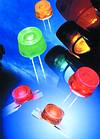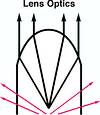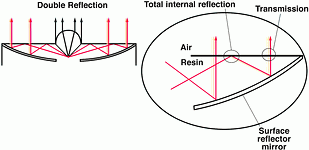

Emerging families of high brightness LEDs are delivering optical output power comparable to traditional incandescent light sources. Designers seeking to improve the safety, service life, efficiency and resilience of lighting solutions are turning to these new devices to achieve their goals. This article summarises the properties that make LEDs attractive for large-scale illumination, and explains how new generation devices achieve the high optical outputs that now allow them to target these applications
Efficiency and longevity
LED technology is arguably the most efficient source of lighting available today. Like many other forms of semiconductor technology, LED design and associated performance continues to advance quickly.
Very low heat loss is among the most fundamental characteristics of LEDs, resulting in low energy consumption and extended operational life compared with alternatives. Moreover, as virtually no heat is produced, LEDs are safe to touch. This is an important advantage as LEDs penetrate an increasing range of consumer-oriented, high power lighting applications.
Typically LEDs exhibit a service life of 100 000 hours. And since an LED is a semiconductor device that uses either resin or some other form of plastic sealed construction, the potential for mechanical failure caused by ageing, shock or vibration is almost nil. How often the LED is operated is of little importance; operational life is chiefly determined by current flow duration at a specified voltage. This allows manufacturers to create solutions that require little or no preventative maintenance or reliance on some form of third-party access. Compared with incandescent lighting and other filament or gas-filled lighting technologies, LEDs enable greater reliability and reduced cost of ownership.
Controllable lighting
LEDs for lighting applications bring further important benefits. It is easy to design and manufacture cost-effective electronic controllers to create lighting effects such as dimming, sequencing or automatic on-off control in response to a timer signal or an external sensor. LEDs also operate faster than most other forms of lighting because they possess very low current draw characteristics. This is important, for example, in automotive applications such as turn or braking indicators, where this speed translates into vital extra reaction time for drivers. Furthermore, the low current draw makes excessive electrical performance degradation highly unlikely. This in turn virtually eliminates any possibility of catastrophic failure.
LEDs are almost monochromatic. That is to say, they tend to emit light in a narrow frequency range, which is a purer and more vivid colour than the light from a traditional incandescent source. This may be desirable in certain applications, such as when illuminating exhibitions or displays. The colour of light emitted by an LED is normally identified as a peak wavelength (lpk) measured in nanometers (nm) and also by spectral half bandwidth (secondary).
Improved visibility
All lighting manufacturers employ various methods to improve visual (optical) output performance, but frequently these measures are restricted to maximising the light output that can be achieved within the system power budget.
However, other parameters such as viewing angle and the directivity of the light source also have a bearing on overall system performance. LED manufacturers are able to optimise these parameters during manufacture, at little cost, through careful design of the chip, its surrounding carrier and the lens assembly. There is little or no need for the system integrator to add expensive extra optical equipment to maximise the efficiency of the light source.
Design techniques for high visibility LEDs
The world market for high optical performance LEDs is expected to increase significantly. By 2005 LED volumes for traffic and signal lighting are expected to exceed 50 billion; around 80 billion LEDs will be used by the automotive sector and around 100 billion will find their way into consumer and commercial indoor lighting products. As LEDs penetrate more applications in these sectors, product designers are clamouring for higher brightness without compromising efficiency.
The conventional 'bullet type' high brightness LED is a typical example of how current generation product attempts to meet this demand for greater output optical power. This type of component relies on a high performance chip normally mounted within a small circular reflective dish (upper side) of the cathode terminal. The LED may be capped either with a diffused or non-diffused plastic package providing protection for the chip and its associated wire bond elements (see Figure 1). This arrangement is perfectly suitable for general use, however it is not the most efficient mechanical design for maximising light output and light direction since a significant degree of light exits sideways from the plastic package.

However, to meet this growing demand for intelligent and efficient lighting, new generations of LEDs are necessary. One example is Omron's super high brightness 'double reflection - light emitting diode' (DR-LED).
Using a patented design, the DR-LED offers up to two times more brightness than conventional bullet type LEDs. This is achieved through the use of a double reflection structure together with an optimised lens. Scientific design has both reduced the amount of light escaping sideways, and made better use of beam directivity control. As a result, the new DR-LED is both twice as efficient and twice as bright as conventional high brightness bullet type (lens optics) LEDs. The successful design incorporates a special surface mirror assembly that reflects LED light in the reverse direction having reflected off the inner side of the lens assembly first (see Figure 2). Due to the wide dispersion nature of the surface mirror, even sideways light is redirected forward and, together with a conventional bullet lens incorporated in the centre, light output is optimised.

Another important aspect of Omron's DR-LED technology is that the precise dimensions required to achieve double reflection are highly repeatable using conventional manufacturing materials and techniques.
Next generation LED applications
Traffic lighting: High visibility roadside and overhead gantry lighting is commonplace on European roads. This is a growth market. LED signage both fixed and portable are the preferred technology especially where road repair is carried out in poor weather conditions. Increasingly these types of signs are also being used for variable traffic control and preventative accident handling (automated traffic management).
Automotive: In practical tests it has been proven that LEDs typically operate much faster than conventional incandescent lamps. For example, the driver behind a car equipped with LED cluster stop lamps will see brake lights a fraction of a second faster than a conventional filament system, travelling at '80 km/h'. This extra warning time potentially equates to an additional car length's worth of stopping distance - a useful benefit when you consider it may reduce the severity or even prevent an accident. In addition, for the mass volume automotive market, new generation LEDs such as the DR-LED delivers powerful new design choices. The number of DR-LEDs may be reduced by up to half in comparison to conventional bullet LEDs, yet still maintain a large equivalent luminous area typically required in stop and direction lamps in all types of vehicles. Using different DR-LED mirror and lens element designs it is possible to accurately control both horizontal and vertical beam distribution, meeting the exacting needs of automotive applications.
Indoor and outdoor lighting: Omron has achieved equivalent optical performance from DR-LED clusters during development tests, which means commercial and consumer lighting products for use in the street, office, at home, in leisure and other lifestyle pursuits can, for the first time, take advantage of LED lighting technology.
Conclusion
The world markets for efficient lighting solutions are growing strongly in response to consumer, environmental and economic pressures. LEDs offer a powerful alternative to conventional, established incandescent light sources and are developing to penetrate an increasing number of these applications including vehicle lighting, highway signage, interior lighting and many other applications. Now that technologies such as Omron's DR-LEDs have proved their ability to challenge strongly for these markets, they will become available in an increasing variety of shapes, sizes and colours to suit diverse applications.
| Tel: | +27 11 579 2600 |
| Email: | [email protected] |
| www: | www.industrial.omron.co.za |
| Articles: | More information and articles about Omron Electronics |
© Technews Publishing (Pty) Ltd | All Rights Reserved